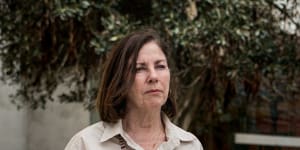At a superficial level,Sydney could claim to be Australia’s cultural capital. Beyond a plethora of small galleries and strong emerging artist network,the inner city boasts the Sydney Opera House on Bennelong Point,Museum of Contemporary Art at Circular Quay,recently expanded Art Gallery of NSW in the Domain,soon-to-be-rebuilt Powerhouse in Ultimo,and increasingly popular Australian Museum near Hyde Park. Further west,$800 million is being spent on the exciting new Powerhouse Parramatta.
These institutions have enriched our lives for so long that we have taken their continued success as a given.

MCA director Suzanne Cotter says entry fees are “not the desirable option” but they may have no choice in order to to keep the museum afloat.Falvio Brancaleone
But through the dogged work of arts writer Linda Morris,theHerald has built a good sense of what is really going on behind-the-scenes – and it’s not a pretty picture. Many of the venues entrusted to protect and showcase our art and history have been slowly strangled by a toxic combination of rising costs and stagnant government funding,seriously undermining Sydney’s claim to be a world-class cultural destination.
Sydney likes to talk a big game when it comes to its cultural footprint,but political interest in the arts often only extends to making sure buildings look good. How the institution itself operates is of less importance to Macquarie Street decision makers,who see little political capital in making sure our galleries and museums have enough money to pay staff,keep the doors open seven days a week,maintain free entry,stage groundbreaking exhibitions,share their collections with regional galleries and museums,and act as an incubator for new talent.
Weeks after theHerald revealed the Art Gallery of NSW had received no extra operational funding despite its footprint doubling last December,another tale of financial struggle has now emerged,this time at the Museum of Contemporary Art.
Its director,Suzanne Cotter,tells theHerald that the MCA has been stoic for years but has reached a “critical point where you can no longer ignore the broader financial picture”. Cotter says the situation is so dire that it is contemplating the reintroduction of ticketed entry – an outcome theHerald believes would be a disaster for Sydney residents and the hundreds of thousands of international tourists the Circular Quay institution draws each year. The imposition of admission fees is usually an option of last resort for any cultural institution for fear of alienating families and to keep their collections accessible to a diverse group of art lovers. Fees also risk further reduction in commercial income from cafes and shops on which the museums increasingly rely.
The MCA is not a state-run institution,so its director is more able to make a fuss than her colleagues at other facilities which come under the government umbrella. But the MCA does rely on state and federal government funding to stay afloat,so the intervention by Cotter is gutsy. It is also risky,should the government decide to punish her or the MCA for speaking out.
TheHerald would encourage Macquarie Street and Canberra to listen to her pleas rather than write off the criticism. As theHerald will reveal over the coming days and weeks,the challenges at the MCA are shared by cultural institutions across our city.
The Minns government is not entirely responsible for this regrettable state of affairs;despite spending big on capital works projects over recent years,the NSW Coalition did not do enough to deal with the operational funding pressures faced by our galleries and museums. However,Labor has the capacity to make sure our cultural institutions don’t have to scrounge around for financial scraps to keep the doors open.
A significant funding boost for the city’s major galleries and museums would make a huge difference to these institutions and be akin to a rounding error for the annual state budget.
Will Premier Chris Minns and Arts Minister John Graham seize the opportunity to nourish our institutions in the same way they have nourished our city’s soul? It is the definition of a no-brainer.
Bevan Shields sends an exclusive newsletter to subscribers each week..